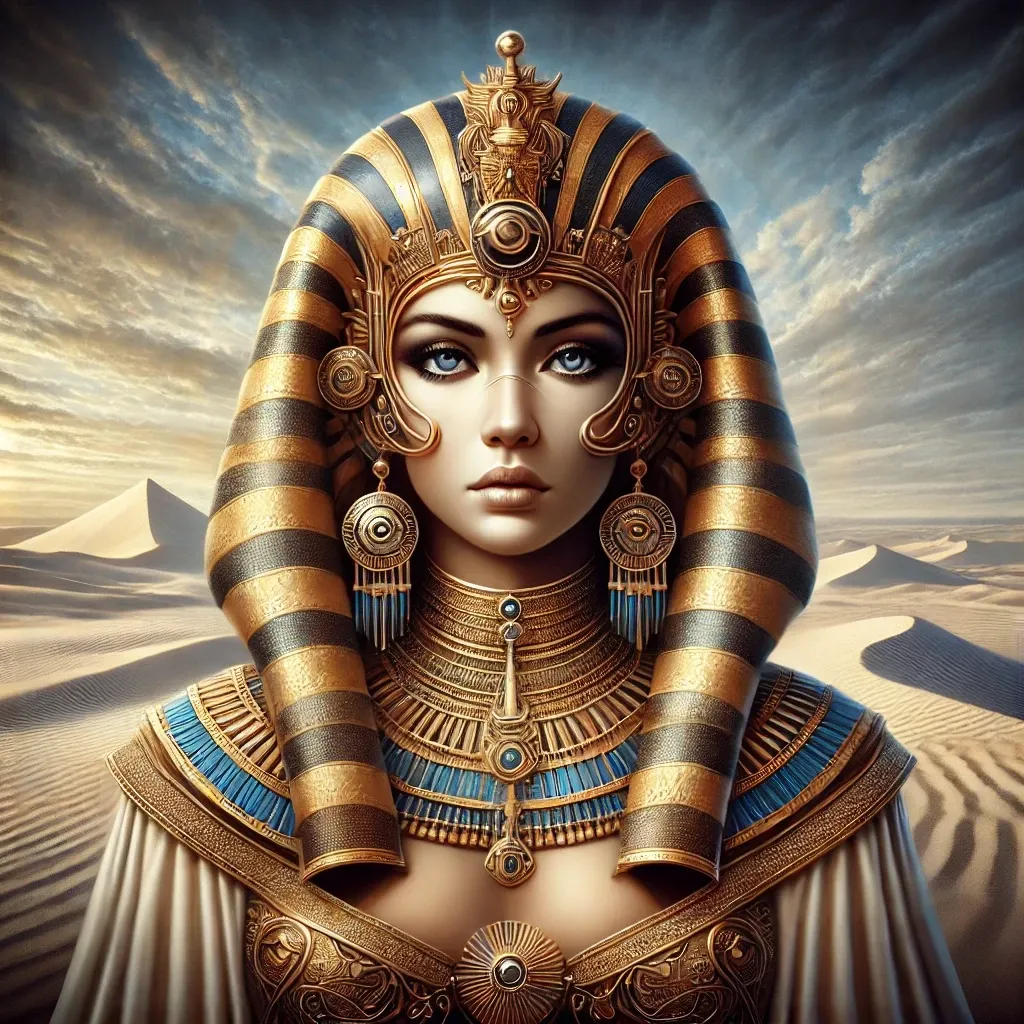In the pantheon of ancient Egyptian deities, few figures are as enigmatic and deeply rooted in the natural world as the goddess associated with grain and harvest. Known by the name Nepit, she was revered as the embodiment of sustenance and fertility, a divine force that ensured the survival of civilizations along the Nile. Her name, derived from the Egyptian word for “grain,” reflects her primary domain, while her epithets, such as “Lady of Abundance” and “She Who Feeds the People,” underscore her vital role in the agricultural cycle. Unlike the more widely known gods and goddesses of Egypt, her influence was subtle yet indispensable, woven into the daily lives of farmers, bakers, and all who depended on the land’s bounty. As a symbol of life’s continuity, she stood at the intersection of nature and divinity, a testament to the ancient Egyptians’ profound connection to their environment.
Origins
Early Mentions in Egyptian Texts
The earliest references to Nepit appear in the Pyramid Texts, some of the oldest religious writings in human history. These inscriptions, dating back to the Old Kingdom (circa 2686–2181 BCE), depict her as a nurturing figure who provides sustenance to both the living and the dead. Her role in funerary texts suggests that she was not only a goddess of earthly abundance but also a guardian of eternal nourishment in the afterlife.
Connection to Agricultural Practices
Her origins are deeply tied to the agricultural practices of ancient Egypt. The annual flooding of the Nile, which deposited fertile silt across the land, was seen as a divine act that mirrored her blessings. Farmers invoked her name during planting and harvest seasons, believing that her favor was essential for a successful yield. Over time, her veneration became intertwined with the cycles of the Nile, making her a cornerstone of Egypt’s agrarian economy.
Evolution Over Time
As Egyptian society evolved, so did her role. During the Middle Kingdom, Nepit began to be associated with broader concepts of fertility and renewal, expanding her influence beyond grain to include other aspects of life. By the New Kingdom, she was often linked to other deities of fertility and creation, reflecting the syncretic nature of Egyptian religion.
Appearance
Anthropomorphic Depictions
In most artistic representations, Nepit is depicted as a woman with a serene expression, often holding sheaves of grain or a scepter symbolizing her authority over the harvest. Her attire typically includes a headdress adorned with ears of wheat or barley, emphasizing her connection to agriculture.
Symbolic Imagery
In addition to human forms, she was also represented through symbolic imagery. Grain itself was considered a manifestation of her presence, and offerings of bread and beer were common in her rituals. Amulets shaped like ears of wheat were worn by devotees to invoke her protection and blessings.
Fusion with Other Deities
In later periods, her imagery often merged with that of other goddesses, particularly those associated with fertility and motherhood. This blending of attributes highlights her adaptability and the enduring relevance of her role in Egyptian spirituality.
Abilities
Control Over the Harvest
Nepit’s primary power lay in her ability to ensure a bountiful harvest. Farmers believed that her favor could mean the difference between abundance and famine, making her one of the most practical and immediate deities in the Egyptian pantheon.
Nourishment in the Afterlife
Beyond the physical world, she was also believed to provide sustenance to the deceased. Funerary texts often depict her offering bread and beer to souls in the Duat (the Egyptian underworld), ensuring their continued well-being in the afterlife.
Influence Over Fertility
While her domain was primarily agricultural, her influence extended to human and animal fertility. Women seeking to conceive would often pray to her, and her blessings were invoked during childbirth to ensure a safe delivery.
Domain
The Agricultural Cycle
Nepit’s domain encompassed every stage of the agricultural cycle, from the planting of seeds to the reaping of crops. She was seen as the divine force that guided the growth of grain, making her an essential figure in the lives of farmers and laborers.
The Nile’s Fertility
The annual inundation of the Nile, which brought life-giving silt to the fields, was considered a manifestation of her power. Temples dedicated to her were often located near the river, emphasizing her connection to this vital waterway.
The Afterlife
In the realm of the dead, Nepit played a crucial role in providing nourishment to souls. Her presence in funerary texts and tomb decorations underscores her importance in ensuring the deceased’s eternal sustenance.
Myths
The Tale of the Famine
One of the most enduring myths involving Nepit tells of a time when the Nile failed to flood, leading to widespread famine. According to the story, she intervened by teaching the people how to store grain and ration their supplies, ensuring their survival until the next harvest. This tale highlights her role as a protector and provider.
The Union with Osiris
In some versions of the Osiris myth, she is depicted as a consort or ally of the god of the afterlife. Together, they symbolize the cycle of life, death, and rebirth, with her grain representing the renewal of life that follows the barrenness of death.
The Harvest Festival
A lesser-known myth describes her descent to earth during the harvest festival, where she would walk among the fields, blessing the crops and ensuring their abundance. This story reflects the intimate connection between her and the agricultural community.
Symbolism
Grain as a Life Symbol
Grain was not merely a crop in ancient Egypt; it was a symbol of life itself. Nepit’s association with grain made her a living embodiment of this vital resource, and her imagery often served as a reminder of the fragility and resilience of life.
The Scepter and the Ankh
In many depictions, she holds a scepter, symbolizing her authority over the harvest, and an ankh, representing eternal life. These objects underscore her dual role as a provider of earthly sustenance and a guardian of spiritual nourishment.
Animals and Plants
While Nepit was primarily associated with grain, certain animals and plants were also linked to her. Doves, symbolizing peace and fertility, were often depicted in her temples, while barley and wheat were considered sacred offerings.
Worship
Temples and Shrines
Though Nepit was not as prominently featured in large state temples as some other deities, she had numerous local shrines and altars dedicated to her, particularly in agricultural regions. These sites often served as community centers where farmers could offer prayers and sacrifices.
Rituals and Offerings
Her worship involved simple yet heartfelt rituals. Offerings of bread, beer, and grain were common, and festivals in her honor often included communal feasts and processions. These practices reinforced her role as a nurturing and accessible goddess.
Evolution of Veneration
Over time, her worship became more integrated with that of other deities, particularly those associated with fertility and the afterlife. Despite this, she remained a beloved figure among the common people, who saw her as a direct link to their daily survival.
Associations
Links to Isis and Hathor
Nepit was often associated with Isis and Hathor, two of the most prominent goddesses in the Egyptian pantheon. These connections highlight her role in fertility and motherhood, as well as her integration into broader religious narratives.
Relationship with Osiris
Her association with Osiris, the god of the afterlife, further cemented her importance in both earthly and spiritual realms. Together, they represented the cyclical nature of life and death, with her grain symbolizing the renewal that follows decay.
Rivalries and Alliances
While she was generally seen as a benevolent figure, some myths depict her in conflict with deities associated with drought or barrenness. These stories emphasize her role as a protector of life and abundance.
Legacy
Decline in the Late Period
As Egyptian society underwent significant changes during the Late Period, Nepit’s prominence began to wane. The rise of foreign influences and the decline of traditional agricultural practices contributed to her diminished role in the pantheon.
Surviving Elements of Worship
Despite this decline, elements of her worship persisted in local traditions and folklore. Farmers continued to invoke her blessings, and her imagery remained a symbol of fertility and abundance.
Modern Rediscovery
In recent years, scholars and enthusiasts have taken a renewed interest in her, recognizing her as a vital yet often overlooked figure in Egyptian mythology. Her story serves as a reminder of the deep connection between humanity and the natural world, a theme that resonates even in modern times.
Trivia
1. Grain Amulets: Small amulets shaped like ears of wheat or barley were commonly worn by farmers and laborers as a form of protection and to invoke Nepit’s blessings for a fruitful harvest.
2. Beer Offerings: Beer, a staple of ancient Egyptian life, was one of the most common offerings made to her, symbolizing both sustenance and celebration.
3. Harvest Songs: Farmers sang hymns and chants dedicated to her during the harvest season, believing that music could please her and ensure a bountiful yield.
4. Connection to Bread: The process of baking bread was considered sacred to Nepit, and bakers often placed small loaves at her shrines as offerings.
5. Grain in Tombs: Grains were frequently placed in tombs as offerings to ensure the deceased would have nourishment in the afterlife, a practice directly tied to her role as a provider.
6. Local Festivals: While not as grand as state-wide celebrations, local festivals in Nepit’s honor often included grain-threshing competitions and communal feasts.
7. Symbol in Hieroglyphs: The hieroglyph for grain was sometimes used as a symbol for her name, emphasizing her deep connection to agriculture.
8. Healing Associations: In some regions, she was invoked for healing, particularly for ailments believed to be caused by malnutrition or poor harvests.
9. Grain Storage Rituals: Before storing grain for the year, farmers performed rituals to honor Nepit, asking for her protection against pests and rot.
10. Depictions in Art: In rare instances, she was depicted as a bird, symbolizing her role in nurturing and protecting the fields, much like a bird caring for its nest.



